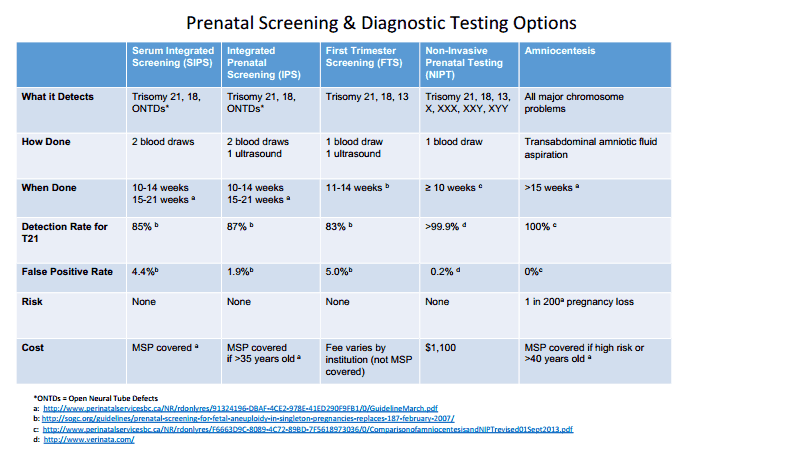
15th November 2013 | by MFC Team
My partner and I just found out that we’re pregnant. Given that we’re both in our late 30s, would you recommend prenatal testing? What prenatal testing options are available and which options are most accurate?
Written by our medical expert Dr. Beth Taylor, co-founder and co-director of Olive Fertility Centre, Vancouver, British Columbia.
Prenatal testing is a very personal decision. Before embarking on the process, I often ask people to make sure that they know what the test they are having can and cannot test for, and to think about what they would do with that information.
Should I have prenatal testing?
Prenatal testing provides health information about the fetus. Some individuals choose not to have prenatal testing as they feel that the information they get from testing would not change what they would do during the pregnancy or after the baby’s birth. Other individuals wish to get testing as they may consider terminating a pregnancy if a specific health issue is detected. Lastly, some individuals get prenatal testing so that they can be more prepared by knowing in advance that their child will be born with a health condition or disability.
What are my risks of having a genetic problem in my pregnancy?
Before prenatal testing, the best estimate of a couple’s chance of having a chromosomal problem (extra genetic material) in the pregnancy is a women’s age at the time of delivery. This is assuming they have no family history of chromosome or genetic problems, birth abnormalities or recurrent miscarriages. For example, a 39-year-old woman has approximately a 1 in 125 chance of having a baby with Down syndrome (1 in 81 chance of any chromosome problem), while a woman of 25 has approximately a 1 in 1250 risk of having a baby with Down syndrome (1 in 476 chance of any chromosome problem).
What are the different types of prenatal testing?
There are several different prenatal testing options currently available and it can sometimes be confusing to understand what the various options are. The term prenatal testing includes both “prenatal screening” and “prenatal diagnosis.”
Prenatal Screening refers to testing a pregnancy to see if it there is a higher or lower chance than would be expected for the pregnancy to be affected with a particular condition. It does not give a definite “yes” or “no” answer, but gives a number or chance that the pregnancy is affected. This type of testing involves blood test(s) and/or ultrasound.
There are several different prenatal screening tests available including Serum Integrated Screening (SIPS), Quad Screening, Integrated Prenatal Screening (IPS), First Trimester Screening (FTS), and Non-Invasive Prenatal Screening (NIPT). Different factors, such as the mother’s age, the stage of the pregnancy, and family history, affect which tests people are eligible for. Some of these options are covered by insurance plans while others are not. The accuracy of the tests are also different and are summarized in the chart that I created with the genetic counsellor at our clinic below. Currently the most accurate prenatal screening test is NIPT, but it often is not covered by some health insurance plans.
Prenatal Diagnosis refers to doing an invasive (risk related) test to give a definitive (yes or no) result. These tests are considered 100% accurate and are offered to some high-risk women (based on the woman’s age, family history, or pregnancy history). There are currently two diagnostic tests available during pregnancy: chorionic villus sampling and amniocentesis. However, they have a small risk of complications from the procedure, including miscarriage.
 Click on table for larger version
Click on table for larger version
It is important to know that prenatal testing is a very personal decision and that there are several options available. Your health care provider can review these various options with you so that you can make an informed decision for your pregnancy.
Leave a Reply